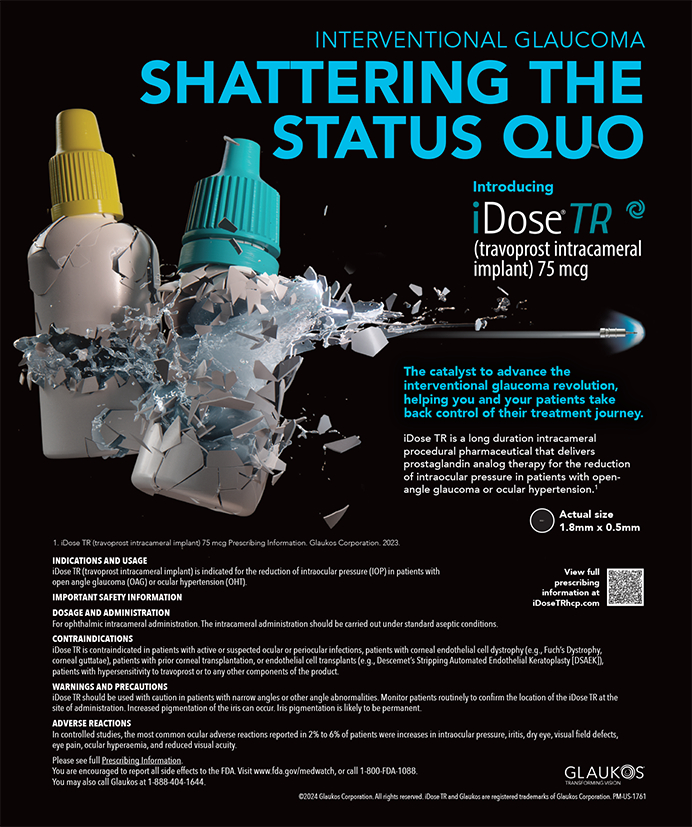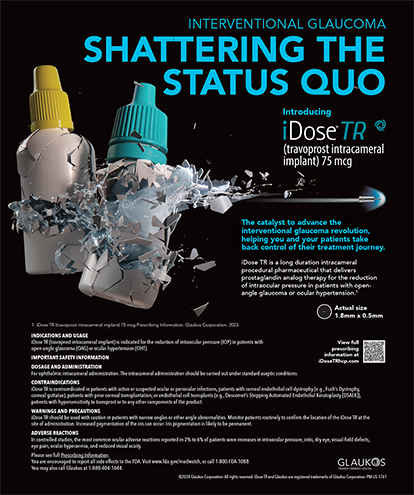“There are those who look at things the way they are, and ask why? I dream of things that never were, and ask why not?”
—Robert F. Kennedy
This article reviews some of my thought processes while performing cataract surgery on patients with weak zonules or zonulopathy (Figure).
MRS. R’S CASE
It is after 9 am, and Mrs. R is late for her appointment. I have already seen the bulk of my postoperative cataract day 1 patients, but I am particularly anxious to see her. Just as I tell my staff to call her or her son, I see Mrs. R stroll into the waiting room with her cane and postoperative visors sealed to her face. “Sorry, I’m late, but Joe had to get some gas,” she says.
I motion for my staff to process her quickly, and within 5 minutes, I enter the examination lane where Mrs. R is sitting and smiling comfortably. “Hey, Dr. J, and how are you this morning?” she asks. I exhale as I open her chart to see her postoperative day 1 visual acuity of 20/60, and I realize things might not be so bad after all. Hers had turned into one of my more complex cases the day before.
As I prepare to examine her eyes, I recall our conversation from a few weeks ago, when I told her son Joe that his mom’s cataract surgery would not be routine and could pose some challenges. Mrs. R is 81 years old. She had an advanced, dense cataract, and her pupil only dilated to 4 mm and revealed numerous flecks of pseudoexfoliation (PXF) on the anterior capsule. She was already at risk for zonulopathy (see Common Causes of Zonular Weakness). Although I did not visualize any phacodenesis, there were some areas of transillumination defects and mild shallowing of the anterior chamber when compared with the contralateral eye. In fact, there are many signs of zonular weakness or zonulopathy that can be seen in the chair and that may help in surgical planning (Table).
THE SURGERY
I had been proactive about surgery on Mrs. R. In the holding area, I chose to numb her eye a little with a mini peribulbar anesthetic block, given her higher risk of posterior capsular rupture. In the OR with Mrs. R on the table, I noted her pupil was no bigger than 4.5 mm despite atropinization in the holding area and intracameral epi-Shugarcaine (3 mL preservative-free lidocaine 4%, 4 mL preservative- and bisulfite-free 1:1,000 epinephrine, and 9 mL BSS Plus [Alcon]). I decided not to use the Malyugin Ring (MicroSurgical Technology) given the pupil’s sufficient dilation, but I did instill trypan blue to stain the capsule, given a diminished red reflex and the PXF flecks. I then used a soft-shell viscoelastic approach in anticipation of performing phacoemulsification in the anterior chamber as much as possible to avoid zonular stress. These steps helped to dilate the pupil to around 5.5 mm.
The medium-sized capsulorhexis, the rate-limiting step in cataract surgery, went well but did manifest some signs of zonulopathy, as the fresh cystotome seemed blunt, and there was obvious wrinkling of the capsule. I usually perform a smaller versus a larger capsulorhexis, as David Chang, MD, advises,2 to improve the chance of a continuous curvilinear capsulotomy and aid in the use of either capsular tension rings (CTRs) or capsular retractors. I made my capsulorhexis a little bigger here, given the patient’s dense nucleus and the goal of tumbling and phacoemulsifying in the anterior chamber. No frank intraoperative phacodonesis was evident. I proceeded with gentle, bimanual, two-instrument hydrodissection and nuclear rotation to be kind to the zonules, which were showing signs of weakness.
DIFFICULTIES
The nucleus was difficult to rotate, and this, right away, led me to use capsular retractors. I favor the Mackool Cataract Support System, because the elongated capsular hooks serve as “pseudozonules” to stabilize the capsular bag during phacoemulsification. I prefer to use CTRs toward the end of the case, right after cortical cleanup, to help support the zonules and prevent capsulophimosis.
Just as many cataract surgeons have their go-to techniques for phacomanipulation, for dense cataracts in eyes with PXF, I employ the phaco-tumble technique while phaco chopping horizontally within the anterior chamber. I find this combination to be the least stressful and traumatic to the unpredictable zonules. I aim for a medium-sized versus a small capsulorhexis in these cases to allow room for tumbling. As previously mentioned, in the presence of weak zonules, 3 a large capsulorhexis can end in a “rhexis gone wild.”
CLEANUP
After the nuclear emulsification, cortical cleanup can be equally or even more challenging in a patient with weak zonules. I tend to use a bimanual I/A approach with as much of a dispersive ophthalmic viscosurgical device as possible, and I remove the often sticky cortex in a tangential fashion. Being gentle on the bag and circumspect is as important as looking out for zonular dialysis. After removing the cortex, I placed a Morcher CTR (distributed by FCI Ophthalmics) for capsular stability prior to placing the lens.
If there is no zonular dialysis or if it is less than 3 clock hours, I find that a single-piece hydrophobic IOL in the bag will just do fine. When I doubt integrity of the capsular bag, I place a three-piece foldable IOL in the sulcus. Larger dialysis or significant decentration leads me to choose a sutured or glued IOL or possibly a modern anterior chamber IOL (preoperative gonioscopy is very important for this reason in zonulopathy cases). Premium IOLs are not an option for me in a case like this one, owing to the lifetime risk of IOL shift, even with a CTR placed.
CONCLUSION
Because there was no dialysis, Mrs. R received a single-piece hydrophobic IOL in the bag, and the case ended as planned. On her day 1 visit, I was relieved to see a well-centered, stable posterior chamber IOL and to have only mild corneal edema to deal with. The patient received a course of postoperative topical antiinflammatories and subsequently did very well.
Zonulopathy can be unnerving for the surgeon. Proper strategies and nimbleness in the OR along with familiar, realistic options help to achieve excellent outcomes. At least, Mrs. R and Joe think so!
Peter George Dentone, a third-year medical student at New York Medical College, Class of 2015, assisted with this article and the tables.
Jai G. Parekh, MD, MBA, is the managing partner at Brar-Parekh Eye Associates, Woodland Park/Edison, New Jersey, and chief of cornea and external diseases/chairman of research at St. Joseph’s HealthCare System, located in Paterson/Wayne, New Jersey. Dr. Parekh is also a clinical associate professor of ophthalmology on the Cornea Service at the New York Eye & Ear Infirmary in New York City. He acknowledged no financial interest in the other products or companies mentioned herein. Dr. Parekh may be reached at (973) 785- 2050; kerajai@gmail.com.
- Marques DMV, Marques FF, Osher RH. Subtle signs of zonular damage. J Cataract Refract Surg. 2004;30:1295-1299.
- Chang DF. Capsulorrhexis. In: Chang DF, ed. Phaco Chop & Advanced Phaco Techniques. Thorofare, NJ: Slack; 2013; 165-167.
- Blecher MH, Kirk MR. Surgical strategies for the management of zonular compromise. Curr Opin Ophthalmol. 2008;19(1):31-35.


